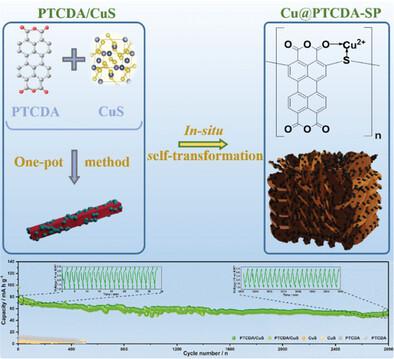当前位置:
X-MOL 学术
›
Adv. Funct. Mater.
›
论文详情
Our official English website, www.x-mol.net, welcomes your
feedback! (Note: you will need to create a separate account there.)
In Situ Formation of Coordinated Polymer via Organic–Inorganic Hybridization Engineering Boosting High-Efficiency Potassium Storage
Advanced Functional Materials ( IF 18.5 ) Pub Date : 2023-08-02 , DOI: 10.1002/adfm.202306424 Hang Liu 1, 2 , Mengyuan Cheng 1, 2 , Zhuocheng Tian 1, 2 , Lianmeng Cui 3 , Di Wu 1, 2 , Dongxue Wang 1, 2 , Liang Zhou 3 , Jianlong Xia 1, 2, 4
Advanced Functional Materials ( IF 18.5 ) Pub Date : 2023-08-02 , DOI: 10.1002/adfm.202306424 Hang Liu 1, 2 , Mengyuan Cheng 1, 2 , Zhuocheng Tian 1, 2 , Lianmeng Cui 3 , Di Wu 1, 2 , Dongxue Wang 1, 2 , Liang Zhou 3 , Jianlong Xia 1, 2, 4
Affiliation

|
Organic redox-active molecules with merits of structure diversity and tunable properties are emerging as promising cathodes for the practical usage of potassium-ion batteries (PIBs). However, the inferior cycle stability and sluggish charge-carrier mobility are two main drawbacks hindering the practical application of organic cathode materials. Herein, highly conductive inorganic CuS is combined with small molecule-based redox species (perylene-3,4,9,10-tetracarboxylic dianhydride, PTCDA) to form a novel organic–inorganic hybrid cathode (PTCDA/CuS) for PIBs, which could undergo electrochemical-induced in situ self-transformation of a sulfur-linked and Cu2+-coordinated PTCDA polymer (labeled as Cu@PTCDA-SP). Benefiting from improved redox sites from activated carbonyl groups, high stability afforded by the sulfur-bridging, isotropic amorphous nature, and 3D cross-linked nanosheet morphologies, the resulting Cu@PTCDA-SP cathode exhibits a high-rate capacity involving trielectron enolization (vs 2-electron transformation in PTCDA monomers) and long-term cycle life (over 2800 cycles at 5 A g−1). This organic–inorganic hybridized cathode is very promising for PIBs. Additionally, the self-transformation strategy provides new insight into the discovery of more electrochemically induced interaction between organic–inorganic hybrids toward high-performance secondary batteries.
中文翻译:

通过有机-无机杂化工程原位形成配位聚合物促进高效钾储存
具有结构多样性和可调特性的有机氧化还原活性分子正在成为钾离子电池(PIB)实际应用的有前途的阴极。然而,较差的循环稳定性和缓慢的载流子迁移率是阻碍有机正极材料实际应用的两个主要缺点。在此,高导电性无机CuS与小分子氧化还原物质(苝-3,4,9,10-四甲酸二酐,PTCDA)结合形成一种新型的PIB有机-无机混合阴极(PTCDA/CuS),可以经历电化学诱导的硫连接和 Cu 2+配位 PTCDA 聚合物(标记为 Cu@PTCDA-SP)的原位自转变。受益于活性羰基改善的氧化还原位点、硫桥提供的高稳定性、各向同性无定形性质和 3D 交联纳米片形态,所得的 Cu@PTCDA-SP 阴极表现出涉及三电子烯醇化的高倍率容量(与PTCDA 单体中的 2 电子转化)和长期循环寿命(5 A g -1下超过 2800 个循环)。这种有机-无机杂化阴极对于PIB来说非常有前景。此外,自转化策略为发现有机-无机杂化物之间更多的电化学诱导相互作用以实现高性能二次电池提供了新的见解。
更新日期:2023-08-02
中文翻译:

通过有机-无机杂化工程原位形成配位聚合物促进高效钾储存
具有结构多样性和可调特性的有机氧化还原活性分子正在成为钾离子电池(PIB)实际应用的有前途的阴极。然而,较差的循环稳定性和缓慢的载流子迁移率是阻碍有机正极材料实际应用的两个主要缺点。在此,高导电性无机CuS与小分子氧化还原物质(苝-3,4,9,10-四甲酸二酐,PTCDA)结合形成一种新型的PIB有机-无机混合阴极(PTCDA/CuS),可以经历电化学诱导的硫连接和 Cu 2+配位 PTCDA 聚合物(标记为 Cu@PTCDA-SP)的原位自转变。受益于活性羰基改善的氧化还原位点、硫桥提供的高稳定性、各向同性无定形性质和 3D 交联纳米片形态,所得的 Cu@PTCDA-SP 阴极表现出涉及三电子烯醇化的高倍率容量(与PTCDA 单体中的 2 电子转化)和长期循环寿命(5 A g -1下超过 2800 个循环)。这种有机-无机杂化阴极对于PIB来说非常有前景。此外,自转化策略为发现有机-无机杂化物之间更多的电化学诱导相互作用以实现高性能二次电池提供了新的见解。


















































 京公网安备 11010802027423号
京公网安备 11010802027423号